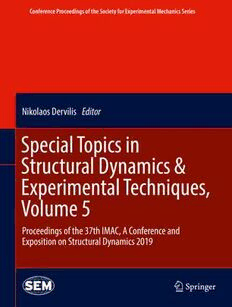Table Of ContentConference Proceedings of the Society for Experimental Mechanics Series
Nikolaos Dervilis Editor
Special Topics in
Structural Dynamics &
Experimental Techniques,
Volume 5
Proceedings of the 37th IMAC, A Conference and
Exposition on Structural Dynamics 2019
ConferenceProceedingsoftheSocietyforExperimentalMechanicsSeries
SeriesEditor
KristinB.Zimmerman,Ph.D.
SocietyforExperimentalMechanics,Inc.,
Bethel,CT,USA
Moreinformationaboutthisseriesathttp://www.springer.com/series/8922
Nikolaos Dervilis
Editor
Special Topics in Structural Dynamics &
Experimental Techniques, Volume 5
Proceedings of the 37th IMAC, A Conference and Exposition
on Structural Dynamics 2019
123
Editor
NikolaosDervilis
UniversityofSheffield
Sheffield,UK
ISSN2191-5644 ISSN2191-5652 (electronic)
ConferenceProceedingsoftheSocietyforExperimentalMechanicsSeries
ISBN978-3-030-12242-3 ISBN978-3-030-12243-0 (eBook)
https://doi.org/10.1007/978-3-030-12243-0
©SocietyforExperimentalMechanics,Inc.2020
Thisworkissubjecttocopyright.AllrightsarereservedbythePublisher,whetherthewholeorpartofthematerialisconcerned,specificallytherights
oftranslation,reprinting,reuseofillustrations,recitation,broadcasting,reproductiononmicrofilmsorinanyotherphysicalway,andtransmissionor
informationstorageandretrieval,electronicadaptation,computersoftware,orbysimilarordissimilarmethodologynowknownorhereafterdeveloped.
Theuseofgeneraldescriptivenames,registerednames,trademarks,servicemarks,etc.inthispublicationdoesnotimply,evenintheabsenceofaspecific
statement,thatsuchnamesareexemptfromtherelevantprotectivelawsandregulationsandthereforefreeforgeneraluse.
Thepublisher,theauthors,andtheeditorsaresafetoassumethattheadviceandinformationinthisbookarebelievedtobetrueandaccurateatthedate
ofpublication.Neitherthepublishernortheauthorsortheeditorsgiveawarranty,expressorimplied,withrespecttothematerialcontainedhereinorfor
anyerrorsoromissionsthatmayhavebeenmade.Thepublisherremainsneutralwithregardtojurisdictionalclaimsinpublishedmapsandinstitutional
affiliations.
ThisSpringerimprintispublishedbytheregisteredcompanySpringerNatureSwitzerlandAG
Theregisteredcompanyaddressis:Gewerbestrasse11,6330Cham,Switzerland
Preface
Special Topics in Structural Dynamics & Experimental Techniques represents one of eight volumes of technical papers
presented at the 37th IMAC, A Conference and Exposition on Structural Dynamics, organized by the Society for
ExperimentalMechanicsandheldinOrlando,Florida,January28–31,2019.Thefullproceedingsalsoincludevolumeson
NonlinearStructures&Systems;DynamicsofCivilStructures;ModelValidationandUncertaintyQuantification;Dynamics
of Coupled Structures; Rotating Machinery, Optical Methods & Scanning LDV Methods; Sensors and Instrumentation,
Aircraft/Aerospace,EnergyHarvesting&DynamicEnvironmentsTesting;andTopicsinModalAnalysis&Testing.
Eachcollectionpresentsearlyfindingsfromexperimentalandcomputationalinvestigationsonanimportantareawithin
structuraldynamics.SpecialTopicsinStructuralDynamicsrepresentspapersonenablingtechnologiesforgeneraldynamics
andbothmodalanalysismeasurements,systemidentification,anddamagedetection.
Theorganizerswouldliketothanktheauthors,presenters,sessionorganizers,andsessionchairsfortheirparticipationin
thistrack.
UniversityofSheffield,Sheffield,UK NikolaosDervilis
v
Contents
1 AStepTowardsTestingofFootProsthesesUsingReal-TimeSubstructuring(RTS)............................ 1
ChristinaInsam,AndreasBartl,andDanielJ.Rixen
2 AugmentedRealityforInteractiveRobotControl................................................................... 11
Levi Manring, John Pederson, Dillon Potts, Beth Boardman, David Mascarenas, Troy Harden,
andAlessandroCattaneo
3 OptimizingLogarithmicDecrementDampingEstimationviaUncertaintyAnalysis............................ 19
JaredA.LittleandBrianP.Mann
4 ASimplifiedCurrentBlockingPiezoelectricShuntCircuitforMultimodalVibrationMitigation............ 23
GhislainRaze,AndyJadoul,ValeryBroun,andGaetanKerschen
5 UsingtheSEREPIdeafortheProjectionofModalCoordinatestoDifferentFiniteElementMeshes ........ 27
WolfgangWitteveen,PöchackerStefan,andFlorianPichler
6 IdentificationSystemforStructuralHealthMonitoringinBuildings............................................. 31
JesúsMorales-Valdez,LuisAlvarez-Icaza,JoséAlbertoEscobar,andHéctorGuerrero
7 ExperimentalandNumericalStudyoftheSecondOrderMomentoftheFirstPassageTimeofaSteel
StripSubjectedtoForcedandParametricExcitations.............................................................. 39
E.Delhez,H.Vanvinckenroye,V.Denoël,andJ.-C.Golinval
8 Three-DimensionalMechanicalMetamaterialforVibrationSuppression........................................ 43
BrittanyC.EssinkandDanielJ.Inman
9 ModelReductionofSelf-RepeatingStructureswithApplicationstoMetamaterialModeling................. 49
RyanRomeoandRyanSchultz
10 Imager-BasedTechniquesforAnalyzingMetallicMeltPoolsforAdditiveManufacturing .................... 63
Cedric Hayes, Caleb Schelle, Greg Taylor, Bridget Martinez, Garrett Kenyon, Thomas Lienert,
YongchaoYang,andDavidMascareñas
11 Full-FieldModeShapeAnalysis,AlignmentandAveragingAcrossMeasurements............................. 71
WesleyScott,MatthewAdams,YongchaoYang,andDavidMascareñas
12 InvestigatingEngineeringDatabyProbabilisticMeasures......................................................... 77
L.A.Bull,K.Worden,T.J.Rogers,E.J.Cross,andN.Dervilis
13 Multi-InputMulti-OutputSweptSineControl:ASteepestDescentSolutionforaChallengingProblem.... 83
UmbertoMusella,BartPeeters,FrancescoMarulo,andPatrickGuillaume
14 StudyonDevelopingMicro-ScaleArtificialHairCells.............................................................. 95
Sheyda Davaria, V. V. N. Sriram Malladi, Lukas Avilovas, Phillip Dobson, Andrea Cammarano,
andPabloA.Tarazaga
15 DynamicCharacteristicIdentification ................................................................................ 101
ClayJordanandTommyHazelwood
vii
viii Contents
16 OneYearMonitoringofaWindTurbineFoundations.............................................................. 107
MartaBerardengo,StefanoManzoni,MarcelloVanali,andFrancescantonioLucà
17 OntheApplicationofDomainAdaptationinSHM ................................................................. 111
X.LiuandK.Worden
Chapter 1
A Step Towards Testing of Foot Prostheses Using Real-Time
Substructuring (RTS)
ChristinaInsam,AndreasBartl,andDanielJ.Rixen
Abstract Despite extensive research in prostheses development, amputees still have to cope with severe limits. Tasks,
such as climbing stairs and running or walking on soft ground are demanding and represent obstacles in everyday life.
Design verification of new devices helps to accelerate the development. However, current test procedures do not include
the dynamic interaction between a prosthesis and the human. Real-time Substructuring (RTS) enables investigation of the
dynamic behavior of a system, here human and prosthesis, by splitting it into numerically simulated components and one
physicalcomponent.Asthistestimitatesrealdynamicconditions,footprosthesescanbeimprovedduringthedevelopment
stage.Inthispreliminarystudy,aone-dimensionalmass-spring-masssystemisinvestigated.Theuppermass,representing
the human being, is simulated numerically on the computer. It is coupled virtually to a prosthesis, represented here as a
spring-masssystem,whichismountedonaStewartPlatform.Bothsystemsexchangedisplacementandforceinformation.
The upper mass tries to follow a periodic desired trajectory, which is influenced by the coupling. This paper describes the
experimentalsetupandtheeffectofdelaycompensation.Inaddition,itisshownhowtheaccuracyandstabilityoftheRTS
simulation depends on the problem description, i.e. how much the system is governed by the mechanical properties of the
numericalpart.AlthoughwearespecificallyconsideringtheapplicationofRTStoprosthetics,thecurrentresearchtackles
genericproblemsthatwillalsohelptoenhanceotherapplicationsinvolvingcontact,e.g.thedockingofsatellites.
Keywords Real-timesubstructuring · Testingofprostheticfeet · Stewartplatform · Real-timehybridtestingwith
contact · Forcecompensation
1.1 Introduction
Testingoffootprosthesesisanexpedientstepinthedevelopmentoffootprostheses.Theaimofprosthesesis,ingeneral,
to emulate the behavior of the missing body part. Despite great advances in the design of foot prostheses, they need to be
improved further to enable amputees to resume a normal everyday life. Walking on uneven and soft ground is one of the
challenging situations for patients because a healthy human foot can balance actively in this situation. Testing procedures
during the early development stage help to accelerate prosthesis development and improvement [1]. Currently, there are
different methods for testing foot prostheses: one approach is that the force and position data are taken from gait analysis
laboratories and incorporated on test benches [2]. Another method for validating the newly developed design is via finite
element modeling [1]. Moreover, prostheses are also evaluated via in-vivo testing. Patients are asked to wear the device
and give feedback. The results from these tests are important, as they give a response on how well the amputees cope
withtheprosthesisineverydaylife.However,eventhoughthisrepresentsvaluablefeedbackforprosthesesdevelopers,itis
notwithoutdifficultiesasitisnotreproducibleandunsafefortheamputees[1,2].Themainadvantageofrobot-driventest
benchesisthattheycanalsomimicpotentiallydangeroussituations,suchastripping,inasafeandreproducibleenvironment.
Therefore,itwouldbeadvantageoustocombinetheadvantagesofallmentionedmethods;apromisingapproachistheuse
ofReal-TimeSubstructuring.
Real-Time Substructuring (RTS) or Real-Time Hybrid Testing is a method for investigating the dynamic behavior of
complex mechanical systems. The mechanical system is split into two parts (or substructures) and each of the parts is
analyzed—one is analyzed in a numerical simulation, the other is investigated on the test bench which is driven by an
actuator. Both simulations are coupled in real-time in order to assess the dynamic behavior of the whole system [3, 4].
C.Insam((cid:2))·A.Bartl·D.J.Rixen
ChairofAppliedMechanics,FacultyofMechanicalEngineering,TechnicalUniversityofMunich,Garching,Germany
e-mail:[email protected];[email protected];[email protected]
©SocietyforExperimentalMechanics,Inc.2020 1
N.Dervilis(ed.),SpecialTopicsinStructuralDynamics&ExperimentalTechniques,Volume5,ConferenceProceedings
oftheSocietyforExperimentalMechanicsSeries,https://doi.org/10.1007/978-3-030-12243-0_1
2 C.Insametal.
Fig.1.1 StewartPlatformused
fortheRTSsimulation
Thismethodwasestablishedandextensivelyusedforearthquakeengineering[5]butisnowadaysalsousedindiversefields,
e.g. for the simulation of wind turbine blades [6] or spacecraft parachute deployment [7]. The applicability of the RTS
methodinbiomechanicshasalsobeenprovenbyHerrmannetal.[8].Theytestedthedislocationofartificialhipandknee
jointsunderphysiologicalconditions.
TheideaoftestingfootprosthesesusingtheRTSmethodwasalsoproposedin[9].Thehumanismodeledinamultibody
simulationwhichissolvednumerically.Theprosthesisismountedonthetestbenchandforceaswellasdisplacementvalues
are exchanged in real-time between the two systems. In [9] it is assumed that stability problems occur due to the highly
nonlinearsystempropertiesandthediscontinuityduetocontact.Extensiveresearchonstabilityproblemsduetodelayand
unknowndynamicsofthetransfersystem(actuatorandcontroller,forcesensor)havebeenconductedoverthelastdecades,
e.g.byHoriuchietal.[10],Darbyetal.[11],Bonnet[12],andBartletal.[13].Furthermore,BogeandMa[14]addressed
contactissuesfortheirapplicationsatellitedocking.Ingeneral,timedelayofthetransfersystembringsnegativedamping
into the simulated system. Therefore, they actively balance the energy input and output so that the total energy does not
increaseandthesystemremainsstable.
Inthispaper,wepresenttheexperimentalsetupfortestingfootprosthesesusingRTS.Thepresentedexperimentalsetup
istestedinanRTSsimulation,whereamass-spring-masssystemthatcanmoveinverticaldirectionservesasthemechanical
systembeingtested.Theeffectsofdelaycompensationusingpolynomialextrapolation[10]areinvestigated.
Section 1.2 introduces the test bench and the coupling problem. The mechanical system as well as the required force
compensation are presented and derived in Sect.1.3. Section 1.4 presents the results of the experiments. It also highlights
issuesregardingcontactproblemsforthestabilityandaccuracyofRTSsimulations.Finally,abriefsummaryandoutlook
aregiveninSect.1.5.
1.2 ExperimentalSetup
A Stewart Platform, shown in Fig.1.1, is used as an actuator for the RTS simulations. Stewart Platforms are six DOFs
manipulatorswithparallelkinematics.Therefore,theyofferthebenefitsofhighstiffnessandaccuracymakingthemsuitable
for use, for example, in milling machines and driving simulators [15]. The Stewart Platform used in this investigation, is
drivenbysixelectricmotorsandisposition-controlledbyadecentralizedcascadecontroller(PPI)[15].Forparallelrobots,
the inverse kinematics can be directly calculated using kinematic relationships in contrast to serial robots, where Newton-
Raphsoniterationsorsimilarmethodsneedtobeused.Thus,thedesireddisplacementcommandfortheToolCenterPoint

